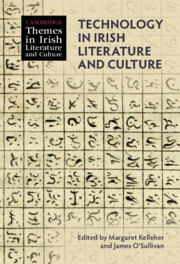Book contents
- Technology in Irish Literature and Culture
- Cambridge Themes in Irish Literature and Culture
- Technology in Irish Literature and Culture
- Copyright page
- Epigraph
- Contents
- Contributors
- Cambridge Themes in Irish Literature and Culture
- Acknowledgements
- Introduction
- Part I Genealogies
- Chapter 1 Print as Technology: The Case of the Irish Language, 1571–1850
- Chapter 2 Printing and Publishing Technologies, 1700–1820
- Chapter 3 The Optical Telegraph, the United Irish Press, and Maria Edgeworth’s ‘White Pigeon’
- Chapter 4 Technologies of Sound: Telephone/Gramophone
- Part II Infrastructures
- Part III Invention
- Part IV The Digital
- Index
- References
Chapter 3 - The Optical Telegraph, the United Irish Press, and Maria Edgeworth’s ‘White Pigeon’
from Part I - Genealogies
Published online by Cambridge University Press: 19 January 2023
- Technology in Irish Literature and Culture
- Cambridge Themes in Irish Literature and Culture
- Technology in Irish Literature and Culture
- Copyright page
- Epigraph
- Contents
- Contributors
- Cambridge Themes in Irish Literature and Culture
- Acknowledgements
- Introduction
- Part I Genealogies
- Chapter 1 Print as Technology: The Case of the Irish Language, 1571–1850
- Chapter 2 Printing and Publishing Technologies, 1700–1820
- Chapter 3 The Optical Telegraph, the United Irish Press, and Maria Edgeworth’s ‘White Pigeon’
- Chapter 4 Technologies of Sound: Telephone/Gramophone
- Part II Infrastructures
- Part III Invention
- Part IV The Digital
- Index
- References
Summary
This chapter explores the cultural significance of the optical telegraph in Ireland. Following the institution of the Chappe télégraphe in revolutionary France, this long-distance communications technology was widely innovated and subsequently adopted by numerous governments including, briefly, the British administration at Dublin Castle. The chapter begins by discussing the promotion, in the Belfast Northern Star, of the telegraph designed by the ‘improving’ Ascendancy landlord, Richard Lovell Edgeworth. It then considers the politics of telegraphic discourse in Ireland in the years leading up to the Rebellion of 1798, with a particular focus on the associations between telegraphy and the United Irish press. Finally, it suggests some points of affinity between Maria Edgeworth’s tale ‘The White Pigeon’ (1800) and her father’s telegraph. In its connection with competing ideas of Irish nationality, security, and surveillance, I argue, the telegraph offers valuable insights into the relations between literature and technology in late eighteenth-century Ireland.
Keywords
- Type
- Chapter
- Information
- Technology in Irish Literature and Culture , pp. 49 - 64Publisher: Cambridge University PressPrint publication year: 2023



